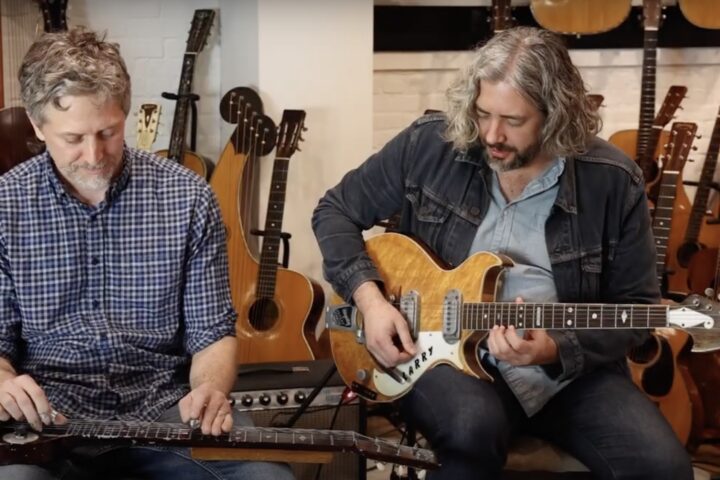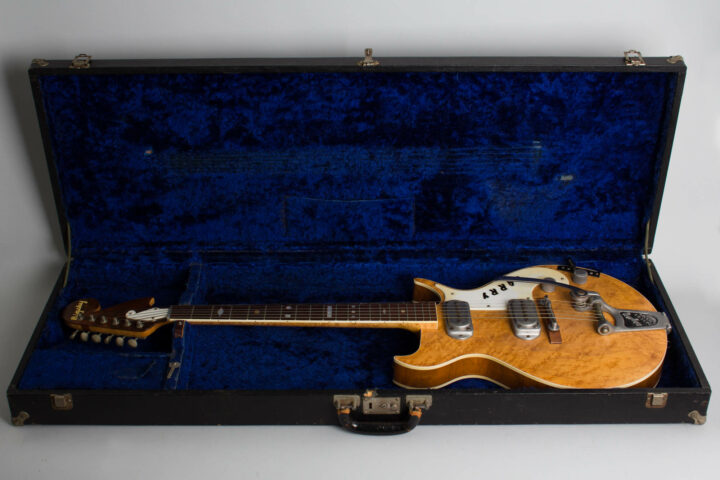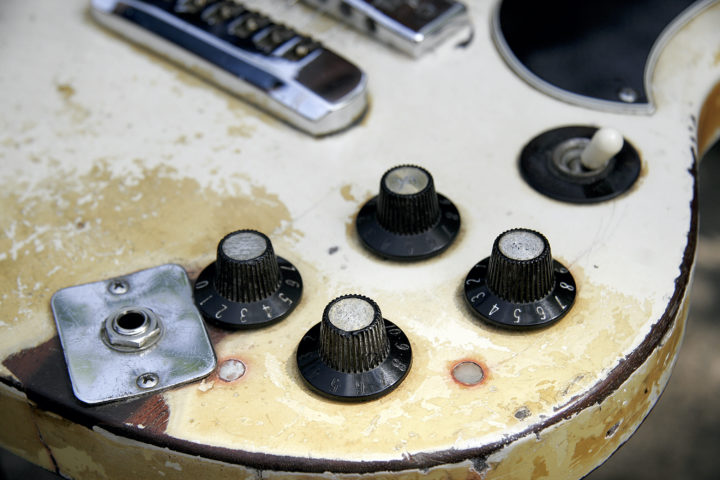The case. The case was what caught my eye as I was scrolling through the online listings of a New York guitar auction in 2016. It was a vintage lap-steel case, a black rectangle customized with a hand-hammered copper design of a 1940s bathing beauty on the case lid. The auction listing was for a “Rickenbacker Prototype Lap Steel Guitar.” The instrument looked sort of like a Rickenbacker from the 1930s, but with an unusual headstock with the letters “P. A.” on it. “Cool case,” I thought, and continued scrolling. But then something else caught my eye: the fretboard. It had the unique pattern of dot- and diamond-shaped markers used on the instruments of Paul Bigsby.
I’d recently become obsessed with Bigsby, the former motorcycle racer and builder who invented the vibrato tailpiece that still carries his name, and who had collaborated with Merle Travis to create the first modern solidbody electric guitar in 1948. I’d read The Paul Bigsby Story by Andy Babiuk, and I was a fan of the guitars of TK Smith, the California builder inspired by Bigsby’s designs. I was fascinated by this inventor and craftsman who’d been buddies with Les Paul and Leo Fender (and greatly influenced both) but who had wanted nothing to do with mass production, making his guitars and pickups one at a time in his small backyard shop in the Los Angeles suburb of Downey.
I went to the auction preview to see the guitar in person. When I held it in my hands, I remember thinking, “This is the guitar a motorcycle mechanic would make.” There was something industrial about it, like it was a piece of machinery. Even though the tuner buttons had crumbled off and it obviously hadn’t been played in decades, I was amazed that it was still very close to being in tune. I was convinced it was legitimate, and when it came time to bid, I went for it.
Meanwhile in California, Bigsby expert Deke Dickerson had also seen the auction listing. “The immediate thing that struck me was, that is no Rickenbacker,” said Dickerson. “And as soon as I saw the initials on the headstock, I just said to myself, holy crap, that is the Bigsby Prototype right there. I knew it as soon as I saw it.”
In 1942, Paul Adelbert Bigsby (his friends called him P. A.) was a foreman and parts fabricator at the Crocker Motorcycle Company in Los Angeles. Bigsby and founder Albert Crocker designed and built some of the most powerful motorcycles of their day, easily outperforming Harley-Davidsons and Indians of the era. But the United States was deep into WWII, and the U.S. government had just imposed restrictions on the use of metals, especially aluminum. Crocker could no longer effectively make motorcycles, and soon switched to making airplane parts for Douglas Aircraft. Due to their technical innovation and rarity (fewer than 100 were made), Crocker cycles are now prized by collectors, fetching upwards of $500,000 when they appear on the market.
Southern California in the 1940s was also a hotbed of western swing and country music, and Bigsby was a regular at shows by Bob Wills and his Texas Playboys, Spade Cooley and his Orchestra, and other groups. He was taking lap-steel guitar lessons, and his instructor had a Rickenbacker A-22 lap steel (a model nicknamed the “frying pan” due to its distinctive shape) made of cast aluminum. Bigsby fell in love with the guitar’s tone and wanted to buy one, but Rickenbacker had stopped making the model years earlier. So without any prior experience making musical instruments, he decided to make one for himself.
“Even for a metal worker or a machinist like he was, I think it was pretty unusual back in those days to be able to cast aluminum,” said Dickerson. “But he’d already been doing that work at Crocker. So when he saw this lap-steel guitar, he probably thought, ‘Oh man, that’s easy compared to casting cylinders or cylinder heads.’”
Out of a single piece of wood, Bigsby carved the guitar’s body, neck and headstock. He then used that wood pattern to make a mold to cast in aluminum. Dickerson theorized that Bigsby may have melted down surplus Crocker motorcycle parts to source the metal, which was almost impossible to find during the war. The one-piece instrument he created vaguely resembled a Rickenbacker, with a small, round body and a solid, rectangular headstock reminiscent of a Martin acoustic guitar. He researched different pickup designs and fashioned a horseshoe magnet pickup assembly from parts he scavenged in junkyards. The volume/on/off switch was probably sourced from an old radio. He finished the instrument with the same deep red metallic paint used by Crocker for its motorcycle tanks. After it was completed, Bigsby may have discovered that the ergonomics of playing his instrument weren’t ideal, and added a wood strip to the back of the neck for better balance.
“Paul Bigsby had the skills, he had the connections and he had access to the materials,” said guitar historian Lynn Wheelwright. “In a way, this instrument was Bigsby’s gateway drug. He’d never made a musical instrument before, but making this one convinced him that he could do it professionally.”
Sometime in 1944, Bigsby went to an L.A. concert by western swing favorites Spade Cooley and his Orchestra, where he approached their steel guitar player Earl “Joaquin” Murphy. Murphy was hugely influential in the steel guitar world at the time, so Bigsby brought along the one he’d made and asked Murphy if he’d like to try it out. Legend has it that Murphy told Bigsby to “get lost,” but Bigsby persisted and Murphy agreed to play it in the band’s next set. Murphy ended up liking it so much that he played it until two o’clock that morning.
“If you can make one like that,” Murphy reportedly said, “then you can make what I want.” What he wanted was a guitar with two eight-string necks, so he could quickly move between different tunings. Bigsby delivered a double-eight-string steel to Murphy later that year, using the same fretboard and headstock design as the prototype but adding two more tuners at the top of each headstock to accommodate the additional strings. When other players saw and heard Murphy’s instrument, the word quickly spread about Bigsby’s skills, and more orders came in. One of those orders was from Merle Travis, who in 1948 showed Bigsby a sketch of what he wanted: a solidbody electric guitar that he could play like a normal six-string. Within six years, Bigsby had gone from a motorcycle parts fabricator to the man who built the first modern electric guitar.
For the next decade, Bigsby continued building steel guitars and the occasional Spanish electric, and began offering his True Vibrato tailpiece that would become his hallmark. By 1965, Bigsby was receiving orders by the thousands and the devices had become standard equipment on guitars from Gretsch, Gibson and others. Bigsby was 65 years old and no longer wanted to deal with the headaches of the business, so he sold the company to Gibson exec Ted McCarty, who showed up with a moving truck and took all Bigsby’s inventory, parts, patterns and manufacturing equipment to Kalamazoo, Michigan. Bigsby bought a new Cadillac, took delivery of it in Detroit and drove it back across the country. He started a hobby business doing letterpress printing in his garage, and became deeply involved with his local chapter of the Freemasons. He died three years later due to lung cancer.
Years earlier, Bigsby had told the story about making that first guitar to a local L.A. newspaper, but no photographs existed of the instrument, and no one knew what had happened to it. For 75 years, it was lost. How did it suddenly appear in a New York auction, misidentified as a Rickenbacker?
On April 23, 1965, a young Beatles fan in Los Angeles named Cathy Barrett celebrated her 14th birthday. Her grandfather, a retired woodworker name Leonard Hooper, brought her a present. “He told me that since I was the only one of his grandchildren who played the guitar, he wanted me to have it,” she recalled. “The instrument didn’t look like my acoustic guitar; in fact it didn’t look like any guitar I had ever seen. It looked more like a pancake with a neck stuck on it.” Her grandfather explained that one of his friends at the Masonic Lodge had made the guitar and given it to him. Befuddled, she put the case in her closet, and held on to it for the next 50 years.
Eventually, the now-married Cathy Barankin relocated to Sacramento, California, and became a successful political advocate on behalf of children’s health and safety issues. Then around 2010, she brought the guitar to an antiques appraisal fair, where an appraiser told her it looked like a Rickenbacker, although with the unique headstock, it might be a prototype. The appraiser theorized that her grandfather must’ve been friends with Adolph Rickenbacker, and this was the version of the story that accompanied the guitar when it was eventually put up for sale.
When I picked the guitar up from the auction house, I received the documentation from Barankin about her grandfather, and started digging. I soon discovered that Paul Bigsby and Leonard Hooper had both been members of the United Masonic Lodge No. 220 in Downey, California. They had co-organized the annual gathering of California Freemasons in the years before Bigsby’s death.
When Deke Dickerson asked Bigsby’s daughter Mary about the lap steel last year, she didn’t remember seeing the guitar as a child. “But the name Leonard Hooper sounded familiar, so I looked up my dad’s will and found that dad had left Leonard his Cadillac.” It’s clear that Bigsby also gave the guitar to Hooper, though we’ll never know when or why.
The first thing that strikes you when you plug in this instrument is the volume: This guitar is loud. Its pickup was fabricated with industrial magnets that are bigger than anything Rickenbacker was using at the time, and Bigsby used a unique split-blade pole piece setup. The cast-aluminum body provides seemingly endless sustain.
Oregon steel guitar-builder Todd Clinesmith acquired some of Bigsby’s original casting molds and patterns in the 1990s, and uses them to make his guitars now. Clinesmith believes the aluminum body and horseshoe pickup combination set a threshold for Bigsby in terms of tone. “I think the reason he chose aluminum had a lot more to do with the tone than it just being the medium he knew how to work in,” said Clinesmith. “That frypan was his inspiration for sure, and he kept that tone in his sights for the rest of his career.”
While the rediscovery of the first Bigsby solves one mystery regarding its creator, more questions remain. “Here’s a guy who made a nationally known product and was hugely influential in the development of the electric guitar, and there are still so many missing holes in his story,” says Dickerson. For instance, he says, no one knows exactly how many instruments Bigsby made. Supposedly he kept files, but those have also been lost, at least for now. “When this guitar popped up, I actually got this warm rush of endorphins coming over me because another piece of Bigsby’s story had dislodged itself from this swirling vortex of obscurity. This guitar is here for us to actually see and touch and admire and study. And I think there are things lurking in people’s closets that might come out in another 50 years or 75 years.”
This article originally appeared in the Fretboard Journal’s second Electric Guitar Annual with additional photos. We’re sharing it online since this guitar recently was listed (and sold) by our friends at Retrofret.com.


